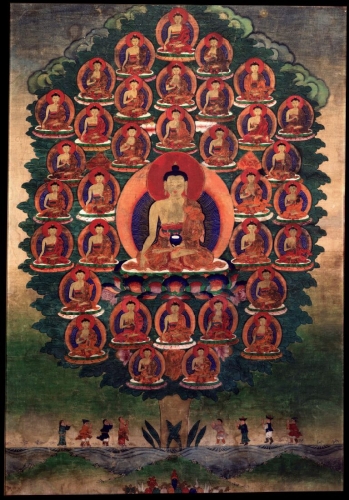Buddhist practice and Buddhist art have been inseparable in the Himalayas ever since Buddhism arrived to the region in the eighth century. But for the casual observer it can be difficult to make sense of the complex iconography. Not to worry—Himalayan art scholar Jeff Watt is here to help. In this “Himalayan Buddhist Art 101” series, Jeff is making sense of this rich artistic tradition by presenting weekly images from the Himalayan Art Resources archives and explaining their roles in the Buddhist tradition.
This week Jeff takes a look at varying depictions of the Thirty-five Confession Buddhas in the Mahayana tradition.
Himalayan Art 101: Confession Buddha Paintings

The Thirty-five Confession Buddhas of the Mahayana tradition is a common subject in Himalayan Buddhist painting and sculpture. Among the various Buddhist traditions there are at least three different iconographic systems for depicting the Thirty-five Buddhas. The principal authors of commentaries and ritual texts were Nagarjuna (likely not the historical Nagarjuna), Sakya Pandita, and Je Tsongkapa along with a number of others, including Jonang Taranatha. The Tibetan Buddhist Resource Center associates approximately sixty texts with the practice of the Confession Buddhas.
There are two distinct textual traditions that explain the Thirty-five Confession Buddhas, one based on the Yogachara philosophical system and the other on the Madhyamaka system—both schools of Mahayana Buddhism. Arising from these two traditions are also two different ritual systems for bestowing the Bodhisattva Vows. Both traditions incorporate the visualization of the Thirty-five Buddhas along with the recitation of the Confession Sutra (Triskhandhadharma Sutra, or the Triskandha Sutra for short).

As for the art and iconography, there are two general types of depiction based solely upon hand gestures and attributes. These iconographies stem from the systems propounded in the commentaries. The first type depicts each of the buddhas with standard hand gestures but without any hand attributes—objects such as flowers, bowls, and symbols of the sun and moon. The second type depicts many or all of the buddhas with hand attributes.

The first example above pictures the Thirty-five Buddhas performing simple hand gestures and arranged in a square configuration around a central Shakyamuni Buddha, the most common central subject in these types of images. Sometimes other popular figures like Amitabha or a bodhisattva such as Maitreya are placed in the central position. The second example shows Shakyamuni holding a begging bowl with the Thirty-five Buddhas arranged around him, all seated in a tree. Both the first and second examples depict the Thirty-five Buddhas with hand gestures only.
The third example has the bodhisattva Maitreya at its center. Arranged around the bodhisattva in horizontal registers are the Thirty-five Buddhas, the majority of them holding both standard and exotic hand attributes (objects). The preferences of particular Buddhist traditions determine which systems of iconographic depiction are followed and used in ritual practice.
Learn more about the Confession Buddhas at Himalayan Art Resources.
Thank you for subscribing to Tricycle! As a nonprofit, we depend on readers like you to keep Buddhist teachings and practices widely available.